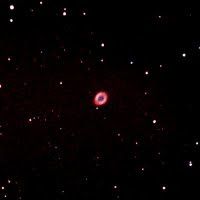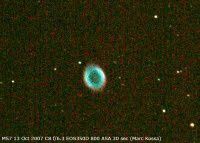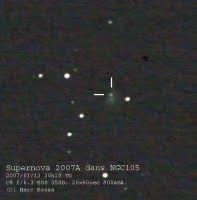11 janvier 2011
2
11
/01
/janvier
/2011
08:56
Magnitude -4,4 (maximum possible -4,7).
Diamètre 24".
Élongation 47 degrés (maximum).
Conjonction inférieure 15 Aout 2011.
Published by marckossa
-
dans
Astronomy
11 octobre 2010
1
11
/10
/octobre
/2010
09:20
Voici 2 photos prises en pose fixe de 6s avec un objectif très ouvert: un 85mm f/1.8 Canon.
6s est la durée de pose maximum avant que les étoiles ne bougent de trop.
La comète est de magnitude similaire au compagnon de M31 (M32), donc de magnitude envion 8.5.



Published by marckossa
-
dans
Astronomy
14 octobre 2008
2
14
/10
/octobre
/2008
23:36


I photographed a white piece of paper in full sunshine, at noon, in raw mode.
I cropped the center of the image, and developped it in 48 bits. Here are the stats reported by
Iris on the center part:
Red: Moyenne : 667.6 Médiane : 671 Sigma : 14.6 Maximun : 742.0 Minimum : 413.0
Green: Moyenne : 1294.5 Médiane : 1310 Sigma : 35.4 Maximun : 1481.0 Minimum : 508.0
Blue: Moyenne : 1106.0 Médiane : 1114 Sigma : 26.0 Maximun : 1245.0 Minimum : 540.0
Taking the median, the RGB adjustments should be:
R: 1.95 (1310 /671)
G: 1
B: 1.18 (1310/1114)
or (reversed, to avoid overflowing on integers):
R: 1
G: 0.51 (671/1310)
B: 0.60 (671/1114)
Published by Marc Kossa
-
dans
Astronomy
13 octobre 2008
1
13
/10
/octobre
/2008
21:54
When doing astronomical images, it is sometimes better NOT to do pre-processing. When the number of dark frames is small for example, as it adds more noise to images than it can remove.
Here are some discussions about this.
Here are 2 images, obtained from the same raw pictures: 30 30-seconds images of m31, taken with Canon 85mm f/1.8.

This one has no pre-processing: hot pixels are visible as small red, green and blue strings (click on it to see it larger).

This one had full pre-processing: dark, flats and offset. When viewed full-size, it doesn't have more signal (it probably actually has less), and overall is doesn't look as good. I only had 1 dark frame to use, as well as only 1 offset and 1 flat field.

For comparision, this one has no pre-processing, but only 10 images stacked together (3 times less). The signal/noise ration is clearly less than the first one with 30 images.
Published by Marc Kossa
-
dans
Astronomy
5 octobre 2008
7
05
/10
/octobre
/2008
17:11
Here are the corresponding arc measures when the 12.5 mm Baader reticule eyepiece is used with the Celestron 8 (no focal reducer). For example, the small circle represents 15 arc seconds of diameter.
15 seconds is also the size of one pixel on the EOS 350D with the 85mm lens.

Published by Marc Kossa
-
dans
Astronomy
1 octobre 2008
3
01
/10
/octobre
/2008
23:54
It is little known that M31, the Great Andromeda Galaxy has not 2 but 4 satellites:
M110 (NGC 205), the ellongated one north of M31 (mag 8.9)
M32 (NGC 221), the round galaxy south of M31 (mag 9.0)
NGC 185 (mag 10.1)
NGC 147 (mag 10.5)
I was able to capture all 4 of them in this simple picture, a composite of 12 individual images taken with the camera piggybacked to my C8, with no guiding. No preprocessing was done, and the frame when a plane crossed the field was also included... Image still goes to magnitude 16.5 !

Right above the white border, on the top part, the variable star
VX And is easily located, due to its vivid red color.
Published by Marc Kossa
-
dans
Astronomy
29 septembre 2008
1
29
/09
/septembre
/2008
21:23
(
voir ici pour une traduction automatique de cette page en français)

This is the star with the highest proper motion of the Heavens: more than 10" every year. See the Wikipedia page on this star
here. I took this picture yesterday, with my Canon 350D DSLR piggy-backed on the C8, with the 85mm f/1.8 lens. Single 30 seconds exposure, no processing except contrast enhancement, and double size for clarity. It is possible to see stars of magnitude 14 on this picture...
The bright star on the left is 66 Oph, magnitude 4.8. It is highly overexposed, and appears less bright than it should be. This is due to the limited dynamic range of the Canon EOS 350D captor . Its design range is 12 bits (4096 values) per pixel. 1 bit is lost in the electrical noise (seen as the sigma value of a dark frame), and 2 more in the suburban sky background. So only 9 bits remain, giving a dynamic range of 512 values, which corresponds to log
2.5(512) = 7 magnitude range. As stars of magnitude 14 can be detected, everything above magnitude 7 is overexposed, and appears dimmer than it should be... This is not a problem, since only 66 Oph is brighter than mag 7 here (next bright star is 7.6).
Published by Marc Kossa
-
dans
Astronomy
21 septembre 2008
7
21
/09
/septembre
/2008
22:58


Spring 1977, Grenoble.
60x700 refractor.

Spring 1986, col de l'Arzelier.
Ready to watch Halley's comet !

Mauna Kea, Hawaii, December 1996.

Mt Palomar, Mai 1997.

A more modest observatory near Grenoble.
Published by Marc Kossa
-
dans
Astronomy
21 septembre 2008
7
21
/09
/septembre
/2008
10:15
Here is M57 in Lyra, taken on June

Here is also M57, taken 11 years later with a smaller telescope, with a
single 30 "exposure...on a digital camera (Canon EOS 350D).

This is M13 in Hercules, also 6 minutes single exposure, from Austin.


Supernovae.

Dim comet.


Edge-on galaxy.

Published by Marc Kossa
-
dans
Astronomy









 Spring 1977, Grenoble.
Spring 1977, Grenoble. Spring 1986, col de l'Arzelier.
Spring 1986, col de l'Arzelier. A more modest observatory near Grenoble.
A more modest observatory near Grenoble. 





